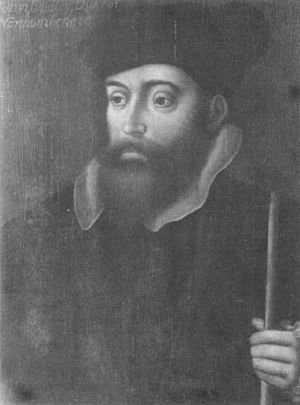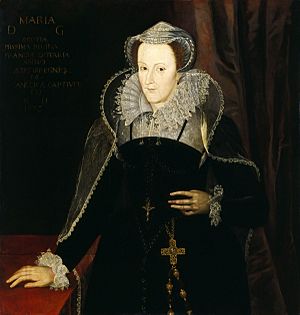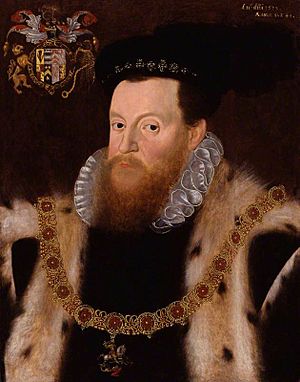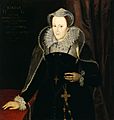Andrew Corbet (died 1578) facts for kids
Sir Andrew Corbet (born 1 November 1522 – died 16 August 1578) was an important English politician during the time of the Tudor kings and queens. He was a Protestant, a type of Christian who did not follow the Pope. For 25 years, he was part of the powerful Council in the Marches of Wales, a special group that helped govern Wales and the areas near it. Sir Andrew came from a wealthy family of landowners, called the landed gentry, in Shropshire and Buckinghamshire. He was elected twice to the Parliament of England to represent Shropshire.
Contents
Early Life and Family
Andrew Corbet was the oldest son of:
- Roger Corbet from Moreton Corbet, Shropshire, and Linslade, Buckinghamshire.
- Anne Windsor, whose father was Andrew Windsor, 1st Baron Windsor.
The Corbet family had owned a lot of land in the Welsh Marches (the borderlands between England and Wales) since the Norman Conquest in 1066. Many family members had served in Parliament. By the Tudor period, they were a rich and well-connected family, even though they were not nobles.
Andrew was named after his grandfather, Sir Andrew Windsor. The Windsors were very important friends for the Corbets. Sir Andrew Windsor had made a huge fortune working for King Henry VII of England. He managed the King's clothes and other important items, handling thousands of pounds each year. He kept his high position even when King Henry VIII took over.
Andrew's father, Roger Corbet, died in 1538 when Andrew was only 16. In those days, if a young person inherited land but was not yet an adult, the King or Queen would take control of their land and arrange their marriage. This was called "wardship," and it was often a difficult time for young heirs. Roger wanted to protect Andrew from this, but Andrew still had to go through wardship.
Luckily, Andrew's uncle, Richard Corbet, was able to use his connections at court to get Andrew's wardship. This meant Andrew's uncle would look after him and his lands. Richard arranged for Andrew to marry Jane Needham by 1542. Andrew and his uncle worked well together, and Andrew later inherited most of Richard's property when Richard died in 1566 without children.
In 1543, Andrew officially took full control of his inherited lands. This process was called "livery."
A Major Landowner
By the time he died in 1578, Sir Andrew Corbet owned land in 40 different areas of Shropshire, making him one of the most important landowners there. He also owned land in many other counties, including Buckinghamshire, Bedfordshire, Cornwall, Herefordshire, Essex, and Hertfordshire.
The Corbet family had strong ties to Buckinghamshire because of their friends, the Windsors. Some of their land there came from Andrew's great-grandmother, Elizabeth Lucy. This included lands in Cublington and Linslade.
In 1546, Andrew Corbet bought the manor of Redcastle in Shropshire from the King for over £550. He continued to add to his land in Shropshire under Queen Mary. He also bought houses in Shrewsbury. However, in 1561, he sold much of his property in Essex.
Corbet mostly lived at Moreton Corbet Castle. He made many changes to the castle, turning it from an old, uncomfortable medieval fort into a more modern and comfortable country house.
Sir Andrew held many important jobs that were usually given to major landowners. He became a Justice of the Peace (JP) for Shropshire in 1547 and kept this job for the rest of his life. JPs were local officials who helped keep law and order. He was also a JP in Gloucestershire, Herefordshire, and Worcestershire in 1554. He was chosen to be High Sheriff of Shropshire three times: in 1550 under King Edward VI, in 1555 under Queen Mary, and in 1561 under Queen Elizabeth. The High Sheriff was the chief law enforcement officer in the county.
Political and Military Work
Working with John Dudley
Sir Andrew Corbet fought bravely in the wars against Scotland during the reign of King Edward VI. He was made a knight in 1547 by John Dudley, a very powerful leader. Dudley saw Andrew's potential and brought him into his group of allies. When Dudley became the head of the Council in the Marches of Wales, he asked for Corbet to be excused from fighting in Scotland so he could help him in Wales. Corbet became a member of the council in 1553. He remained on the council even after Dudley lost power. Corbet continued to do well during Queen Mary's reign, even though he was a Protestant.
Member of Parliament for Shropshire
Corbet was elected as a Member of Parliament (MP) for Shropshire in 1555. He was chosen first, alongside Sir Henry Stafford. Sir Andrew voted against an important government bill, showing his independence. This was notable because he had just been chosen as Sheriff for Shropshire, a job that required loyalty to the Queen. He also helped collect money for the Queen in 1558, which was used to pay for England's part in a war that led to the loss of Calais, an important English territory in France.
Sir Andrew was elected again to Parliament in 1559, during the first Parliament of Queen Elizabeth I. This Parliament helped set up the Elizabethan Religious Settlement, which established the Church of England. The election for Shropshire was not challenged, and Sir Andrew served with Sir Arthur Mainwaring, another active local official.
A Trusted Official
Corbet was very busy in his region during Queen Elizabeth's reign. A big part of his work was with the Council in the Marches. From 1560, the council was led by Sir Henry Sidney, who was often involved in Irish affairs. Sir Andrew took on more and more responsibility, signing orders for the council from 1574. He also had many military and civil jobs in Shropshire and other places.
In 1560, Corbet was sent to Berwick-upon-Tweed with 200 men to help Queen Elizabeth support the Scottish Reformation against French interference. The English army surrounded the French in Leith. After the French leader died, talks began, and the soldiers could relax a bit. Corbet was among the English soldiers who shared a meal with the French during the truce. A letter described how the English brought good food, while the French joked that they had only "a pasty of a baken horse, and six rats well roasted," showing how little food they had left.
Even though the meeting was lighthearted, the Shropshire soldiers suffered many losses. A record from November shows that the Queen paid Sir Andrew Corbet for 200 men, "less thirty-seven who are dead."
This experience made Corbet more interested in military matters. He was put in charge of military inspections in Shropshire in 1562. He took this job seriously, checking the county's readiness for war and reporting on the state of their armor. His report in 1569 suggested creating a small standing army.
Corbet's strong support for the Protestant faith was well-known. In 1564, the bishops told the Queen's Privy Council that he was strong in his religion and that his advice was helpful for understanding the religious views of other JPs. In 1569, when there were rumors of a plot by Thomas Howard, 4th Duke of Norfolk, a government spy described Corbet as "the only staid man, most secret, true and faithfullest to his prince." He was called "the fittest man for a charge wherein consisteth the stay of the country," meaning he was the best person to keep the area stable.
In 1571, with more plots happening, the Privy Council wrote to trusted officials like Corbet to help choose good Members of Parliament. Corbet was the only person in Shropshire to receive this letter. He wrote to the officials in Shrewsbury to arrange an election that would please the Queen.
Later that year, Corbet had to excuse himself from collecting taxes because he was busy arresting Lawrence Banester. Banester was a recusant (someone who refused to attend Church of England services) and an agent for the Duke of Norfolk, who was suspected of plotting against the Queen. Banester was spreading rumors and trying to encourage rebellion in favor of Mary, Queen of Scots. Corbet and others were sent to arrest him, search his home, and take his papers. Corbet found letters that proved Banester's guilt. The next day, the Duke of Norfolk was arrested. Corbet continued to interview witnesses, uncovering Banester's long campaign against Queen Elizabeth. Banester eventually confessed, but Norfolk was executed.
Corbet's involvement in local affairs grew even more. From 1573 to 1578, he was Shropshire's commissioner for many different things, like managing the justice system, sewers, and inspecting tanneries (places where leather is made). When Walter Devereux, 1st Earl of Essex, an important landowner in the region, died in 1576, he named Corbet as one of the officials to manage his estates.
In 1575, when Sir Henry Sidney left to become the Lord Deputy of Ireland for a second time, he formally appointed Corbet as the vice-president of the Council in the Marches. Some people worried that Corbet was too sick for the job, but he proved to be very capable and worked hard to stop corruption. When a famine followed a plague in Shrewsbury, he worked to get more food supplies. He wrote to the town officials in 1576, offering to buy food from other markets for the struggling town. His wife, Jane, died in early 1577. As his own illness got worse, he had to resign from the vice-presidency later in 1577. The Queen wrote back, saying she wished she could have used him longer and asked him to report on the state of the marches.
Death and Legacy
Sir Andrew Corbet died on 16 August 1578. The local record in Shrewsbury described him as "such a jewel to all Shropshire that the like was not for many years before." He was buried in St. Bartholomew's Church in Moreton Corbet, right next to his home at the castle.
Because Sir Andrew did not make a will, his oldest son, Robert, took control of the estate. Robert finished some of the castle's improvements, including carving Sir Andrew's initials, SAC, above the gatehouse in 1579. However, Robert preferred a more modern style and soon began building a grand new house in the Italian style next to the castle.
Family Life
Sir Andrew Corbet married Jane, the daughter of Sir Robert Needham. They had six sons and five daughters, including:
- Robert Corbet, who inherited Sir Andrew's lands. He had already been an MP for Shropshire. He died from the plague while visiting his uncle in London.
- Richard Corbet, who became an MP for Shropshire and inherited the family lands after his older brother Robert died.
- Sir Vincent Corbet, Sir Andrew's youngest son, who inherited the family lands after his brother Richard died.
- Sir Andrew Corbet, Sir Vincent's son, was also a well-known MP for Shropshire.
- Sir Vincent Corbet, 1st Baronet, the second Sir Andrew's son, was a Royalist soldier during the English Civil War.
- Richard Corbet, another of the second Sir Andrew's sons, was also a famous Royalist soldier.
- Sir Andrew Corbet, Sir Vincent's son, was also a well-known MP for Shropshire.
- Anne Corbet, who was the first wife of Sir Walter Leveson, a rich landowner and MP.
- Richard Leveson, their son and Sir Andrew's grandson, was a distinguished sailor who became a Vice-Admiral.
Images for kids
-
John Dudley, from a painted panel at Penshurst Place. Dudley was an early ally and patron of Corbet.
-
Mary, Queen of Scots after Nicholas Hilliard. The crisis of 1569–71 centred on schemes to marry Mary to Norfolk and to place her on the English throne.
















